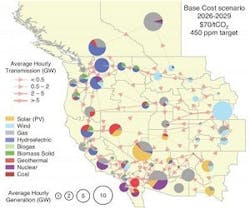Replacing Coal with Renewable Energy
According to a new study by University of California, Berkeley the least expensive way for the Western U.S. to reduce greenhouse gas emissions enough to help prevent the worst consequences of global warming is to replace coal with renewable and other sources of energy that may include nuclear power.
The experts reached this conclusion using SWITCH, a highly detailed computer model of the electric power grid, to study generation, transmission and storage options for the states west of the Kansas/Colorado border. The model will be an important tool for utilities and government planners.
"Decarbonization of the electric power sector is critical to achieving greenhouse gas reductions that are needed for a sustainable future," says Daniel Kammen, Distinguished Professor of Energy in UC Berkeley's Energy and Resources Group. "To meet these carbon goals, coal has to go away from the region."
While some previous studies have emphasized the high cost of carbon taxes or caps, the new study shows that replacing coal with more gas generation, as well as renewable sources like wind, solar and geothermal energy, would result in only a moderate increase to consumers in the cost of electric power – at most, 20%. They estimate a lower ratepayer cost, Kammen said, because the evolution of the electrical grid over the next 20 years – with coordinated construction of new power plants and transmission lines – would substantially reduce the actual consumer cost of meeting carbon emission targets.
Burning coal, a non-renewable resource, produces around 20% of the world's greenhouse gases, but also releases harmful chemicals into the environment such as mercury, sulfur dioxide, nitrogen oxides and sulfuric acid, responsible in some areas for acid rain and respiratory illness.
California has few coal-fired power plants, but gets about 20% of its electricity from coal-burning plants in neighboring states. About 46% of the state's power comes from gas-burning plants, 11% from hydroelectric, 14% from nuclear and 11% from other renewables: geothermal energy, wind and solar.
The study, published in the April issue of the journal Energy Policy, highlights an analysis using the SWITCH electricity planning model. SWITCH, which stands for Solar, Wind, Hydro and Conventional generation and Transmission Investment, uses unprecedented detail that includes generation, transmission and storage of electricity. The model was developed by Matthias Fripp to study California's renewable energy options while he was a Ph.D. student at UC Berkeley. Kammen and his group extended the model's capabilities and used it to study Western North America.
"We use the SWITCH model to identify low-carbon supply options for the West, and to see how intermittent generation may be deployed in the future," says first author James Nelson, a UC Berkeley graduate student. "We show that it is possible to reach our goals of reducing carbon emissions using many possible mixes of power, whether natural gas, nuclear, solar, wind, biomass or geothermal."
"Models like this are eagerly anticipated by many of the agencies involved in planning," Kammen said, noting that SWITCH is a power-system model that can be fine-tuned for many different types of studies.
